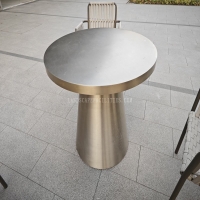Welcome to the website for landscape facilities products and knowledge.
How does the choice of material affect the heat retention of a landscape bar counter in sunny climates?
The selection of material for a landscape bar counter in sun-drenched environments is a critical decision that directly influences thermal performance, user comfort, and long-term durability. In sunny climates, where solar radiation is intense and prolonged, materials absorb and retain heat differently, creating vastly different experiences. This is not merely a matter of comfort but also of functionality and safety.
Materials with high thermal mass, such as thick natural stone (granite, bluestone) or concrete, absorb significant amounts of solar energy. While they heat up slowly in the morning, they can become intensely hot by the afternoon and release that stored heat long after the sun has set, creating a radiant heat source that can make evening use uncomfortable. The dark color often associated with these materials exacerbates this effect due to low albedo (reflectivity).
Conversely, materials with lower thermal mass and higher reflectivity perform better. Light-colored porcelain pavers or tiles, for instance, reflect a substantial portion of solar radiation rather than absorbing it. Their manufactured composition often includes minerals that are less conductive, allowing them to remain noticeably cooler to the touch even under direct sunlight. Certain composite materials engineered for outdoors are also designed with non-conductive resins and fillers that inhibit heat transfer.
The physical properties of the material are paramount. Density, specific heat capacity, and surface texture all contribute. A porous material like travertine might feel slightly cooler initially due to its micro-air pockets, which provide insulation, but it can still reach high temperatures. Sealing these materials can sometimes alter their thermal properties slightly. Stainless steel, while durable, is a prime conductor of heat and can become dangerously hot, making it a poor choice for primary surfaces in full sun, though it may be suitable for shaded applications.
Beyond the base material, design integration plays a supporting role. Incorporating a countertop shade structure, like a pergola or umbrella, is the most effective strategy to mitigate heat gain regardless of material choice. Additionally, selecting a light or neutral color for the surface will dramatically reduce heat absorption compared to a dark brown or black finish.
Ultimately, the optimal choice balances aesthetics with physics. For the coolest surface in a sunny climate, light-colored, high-albedo materials with lower inherent thermal mass, such as specific porcelain slabs or engineered composites, are superior. Understanding this material science ensures your outdoor bar remains a comfortable and functional oasis rather than a scorching inconvenience.
Related search:

Recommendation
Outdoor Metal Table - Classic Outdoor Furniture, Stainless Steel Table, Durable and Reliable